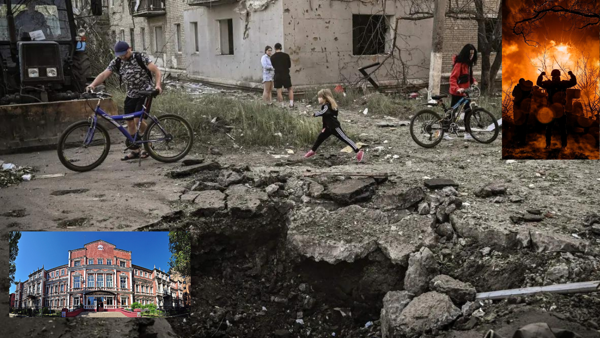
History of "Meat Grinder" Bakhmut
Bakhmut has witnessed several eventful moments in her long historical timeline, starting from coming into existence to today's total destruction. The city holds prominent political, economic, and defensive significance in its prolonged historical journey. The origin of the name of the city, Bakhmut, is certainly uncertain that's why some presumptuous assumptions have arisen from some Historians. According to historians, the origin of the word Bakhmut is a distorted version of the word "Muhammad/Mahmud" in Turkish or Tartar and the second version is quite admissible because the second reason draws its source from "saltwater" and the presence of salt is abundant in Bakhmut basin.
Bakhmut is an administrative center of Bakhmut Raion (district) in Donetsk oblast, located on the bank of Bakhmutovka river (a tributary of the Donets river) & situated 89km northeast of Donetsk's capital Donetsk. The city has gone through some name changes since its inception. It was named Bakhmut when it came into existence but in 1924 its name changed to "Artemivsk" or "Artyomovsk" and it lasts until 2016. Again on 4th February 2016, the "Verkhovna Rada" of Ukraine (Unicamal parliament of Ukraine) confirmed the name of the city by returning to the original one. There was a reason behind it, just before 2016, the Euromaidan revolution (2014) happened against Russian influence and Russia annexed Ukraine's territory of Crimea, right after that the sentiment against Russia grow in Ukraine and Ukraine changed its name using the sentiment against Russia and set up a symbolic signature for all Ukrainians people. In 2014 the Bakhmut was briefly captured by Pro-Russian rebels but later Ukrainian army used force to vacate the city. Si, Prior to 2020, when the designation was abolished, Bakhmut was designated a "city of Regional Significance" because Russia was preparing to attack Ukraine since then, and Bakhmut was at the center point of Russian rage.
Evidence of Bakhmut goes back to 1556, but the first official mention of Bakhmut dates from 1571. Even though, the history of Bakhmut before 1571 is very sparse. It was initially a border post and later became a fortified town. The original existence of Bakhmut came into prominence in the 17th century when Russians built a fort there to protect their land from the invasion of Crimean Tatars.
In 1701, Peter l, the great ordered the fort at Bakhmut to be upgraded and the adjacent Sloboba of Bakhmut to be a designated village. The population of Bakhmut doubled when Peter I established Backmut as a salt harvesting town, but the town was destroyed in the autumn of 1705, due to the Bulavian Rebellion (The war between the Don Cossacks & the Tsardom of Russia).
After Bulavian Rebellion (Astrakhan revolt) the town was captured by a detachment of Cossacks headed by Ataman Kondraty Bulavian until March 7, 1708, when it was taken by government troops. From 1708 to 1725 Bakhmut was assigned to the Azov government.
From 1753 to 1764, it was a major city of Slavo-Serbia, a territory inhabited by colonies from Serbia & elsewhere. In 1783, Bakhmut became a city within Yekaterinoloav Province. It became an industrial town of the European east that produced bricks, candles, soap & great amount of salt. At that time the city had 150 shops, a hospital, and 3 schools. It turned into a business hub with a turnover of more than 1 million Rules.
On 2nd August 1811, the city emblem was approved. On 25th January 1851, the city became a municipality, with Vasily I. Pershin as mayor. After that, Bakhmut became an important city for the Russian empire with 12% of the total Russian salt output.
Alongside salt, it became a production hub of Alabaster, Plaster, Brick, Tile & Soda ash. At the beginning of the 20th century, the city developed a metal industry as well as a chemical industrial hub for Russia. By 1900 the city had 76 small industrial enterprises, which employed 1078 workers, as well as 4 salt mines, which employed 874 workers. The chemical industry of the city was depends on local supplies of limestone & coke.
During Second World War, German troops occupied Bakhmut for almost 2 years, from 31st October 1941 to 9th May 1943. Nikolai Mikhailovich Zhorov was the secretary of the underground city party committee during the occupation in 1943. Later the town was liberated by Soviet forces from the hand of Nazi Germany.
In today's time also, Bakhmut meets the same fate after Russia's special military operation against Ukraine. Bakhmut has turned into a ghost city without electricity, running water, and the existence of Humans because Russia is targeting this city since August 2021, 80% city's population deserted the city at its inception and remained left after Russia intensifies its bombardment. Now the city has earned its name because of the intense trench fight between Russians and Ukrainians. Once one of the most beautiful cities in Europe with historical significance now totally decimated by indiscriminate bombardment from both sides.
Peace has become a distant sun in today's time. The Russians have turned Ukraine into Europe's Afghanistan the way Americans did to Afghanistan to sway USSR from Afghan land by creating Jihadi tanzeems using Pakistan as a stooge. This time stooges are from European nations, especially Western Europeans. Americans are using Europe to fulfill their geo-political goals like the way they use Pakistan to fulfill its geo-political goal in the Indian subcontinent and middle east. Russians are a serious contender to win this race. In Russia's words, Europe is the doormat of the USA and Americans are using them relentlessly. Russia and the USA have made themselves each other's stern enemies to use peace as business and war as money that's why the world should maintain equal distance from both of them.
0 Comments